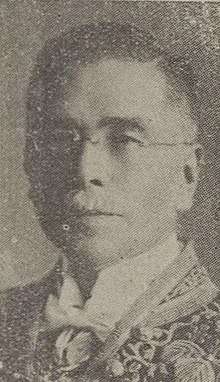Keizo Dohi
Keizō Dohi (土肥 慶蔵, Dohi Keizō, July 20, 1866 – November 6, 1931) (his pseudonym was Gakken) was a Japanese dermatologist and urologist. He was a professor of Dermatology and Urology at Tokyo University, he substantially introduced Western dermatology to Japan. Because he learned not only dermatology but also urology in Europe, Japanese universities created a Department of Dermato-urology, the separation of these two specialities took many years.
Keizō Dohi | |
|---|---|
 Keizō in 1929 | |
| Born | July 20, 1866 Takefu, Fukui, Japan |
| Died | November 6, 1931 (aged 65) |
| Nationality | Japanese |
| Occupation | Physician, Professor of Dermatology, Tokyo Imperial University (1898 - 1926) |
| Known for | Named a skin disease Keratosis follicularis squamosa Dohi. |
Personal history
Born in Takefu, Fukui he was the second son of a physician, he moved to Tokyo at age 15 and studied German at the Shingakusha private school, and later at the Tokyo University of Foreign Studies, where he was enrolled in the preparatory course of the medical school in 1885. After graduation in 1891, he went to the Department of Surgery under Julius Karl Scriba. In 1891, he went to Germany to study surgery, but later he was ordered to study dermatology by the Ministry of Education since Murata Kentarō, the first professor of dermatology at Tokyo University had died.
He studied dermatology in Vienna under Moritz Kaposi, syphiliology under Lange, and urology at Paris University under Guyon. In January 1898, he returned to Japan and in June assumed the post of Professor of Dermatology, Tokyo University. He remained in this post until 1926. He started the Japanese Dermatological Association and held many conferences. In 1931, he died in Tokyo.
Keratosis follicularis squamosa Dohi
Keratosis follicularis squamosa Dohi is a kind of follicular keratosis, in which scales appear elevated from skin surface reminding one of the floating leaves of the lotus.[1][2]
Gakken Collection
He collected a large collection of valuable books, which are to be found in Tokyo University.
World history of syphilis
In 1921, he wrote the World history of Syphilis, which was translated into German.
Leprosy
While he was studying in Europe, he attended the first Congress of Leprosy in 1897 in Berlin. In 1912, he reported a review of treatments of leprosy; among various drugs, he recommended chaulmoogra oil based on his experience.
Moulage
He learned the technique of moulage (wax modeling) in Vienna and introduced its practice to Japan. This technique had greatly contributed to medical education, however, the use of color film in recording skin manifestations made moulage obsolete.[3]
References
- Keratosis follicularis squamosa (Dohi) associated with pseudoacanthosis nigricans. Tamiya H, Tsuruta D, Umeda R et al.(2004) Br J Dermatol. Mar;150(3):603-5.
- Keratosis follicularis squamosa (Dohi): a follicular keratotic disorder well known in Japan.(2001) Shimizu S, Shimizu T, Tateishi Y et al. Br J Dermatol. 144(5):1070-2.
- 皮膚疾患のムラージュ アンケート調査と史的展望 長門谷洋治 皮膚病診療 13,3,248-254,1991 図譜 残ったムラージュと消えたムラージュ 小野友道 Visual Dermatology 7,2,192-193,2008